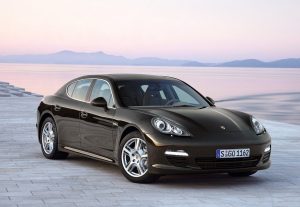Recalls: Porsche 970 Panamera
Overview
Manufacturers, or importers, issue recalls for defects or faults which have the potential to cause injury. Generally, manufacturers will inform the original buyers if their vehicle is subject to a recall and of the steps required to remedy the defect or fault. Please note that the recalls below (if any) are for Australian-delivered vehicles only. Furthermore, the number of recalls should not be taken as an indication of a model’s reliability or its safety more generally.
Recalls: Porsche 970 Panamera
Porsche 970 Panamera S, 4S and Turbo: seatbelt mount could detach
In April 2010, a recall was issued for Porsche Panamera S, Panamera 4S and Panamera Turbo models. For these models, the seatbelt mount could become detached from the anchoring system when fastened or opened such that the restraint function of the belt may no longer operate. For the VINs of the recalled vehicles, see PRA 2010/11575.
Porsche 970 Panamera Turbo S: defective turbochargers
In July 2012, a recall was issued for the Porsche Panamera Turbo S vehicles due to the installation of turbochargers which did not conform to quality standards – in extreme cases, subsequent engine failure could result in a fire in the engine bay (PRA 2012/13212). The recalled vehicles had the following VINs:
- WP0ZZZ97ZCL080022;
- WP0ZZZ97ZCL080459;
- WP0ZZZ97ZCL080025; and,
- WP0ZZZ97ZCL080576.
Porsche 970 Panamera S Hybrid: fuel leak from fuel rails
In March 2015, a recall was issued for Porsche Panamera S Hybrid models. In these vehicles, a fuel leak could occur at the fuel rails in the injection system. In the presence of an ignition source, the fuel leak could pose a fire hazard. The VINs of the recalled vehicles are available at PRA 2015/14620.
2009-16 Porsche 970 Panamera: short circuit in air conditioning blower
In June 2019, recall campaign AKA7 was issued for Porsche 970 Panamera vehicles that were available for sale in Australia from 12 July 2009 to 13 September 2016. Moisture could get into the control unit for the air conditioning blower, causing malfunctions and short circuits in the blower control system. In extreme cases, a short circuit could cause a fire. For the VINs of the recalled vehicles, please see PRA 2019/17554.
2008-16 Porsche 970 Panamera: transmission may not engage park
In July 2019, recall campaign AKB1 was issued for Porsche 970 Panamera vehicles that were available for sale from 20 August 2008 to 13 September 2016. The plastic sleeve of the selector lever cable may not be durable throughout the service life of the vehicle. If the plastic sleeve broke, the transmission may not change into ‘park’ when the driver shifted the lever into the ‘park’ position. The vehicle could therefore unintentionally roll away, posing a hazard to vehicle occupants and others. For the VINs of the recalled vehicles, please see PRA 2019/17657.
Problems and faults: Porsche 970 Panamera
Overview
This section identifies potential problems, causes and fixes based on the experiences of owners and repairers, online sources and technical service bulletins. This information is provided solely for reference purposes and AustralianCar.Reviews recommends that only properly qualified persons carry out repairs or modifications. Furthermore, the number of items below should not be taken as an indicator of a model’s reliability or the frequency with which they may occur.
To report a problem or fault to the AustralianCar.Reviews team, please use the Contact Us form. Note that AustralianCar.Reviews does not offer advice on automotive problems or disputes; such enquiries will not receive a reply. For vehicles purchased from dealers after 1 January 2011, please see our Australian Consumer Law fact sheet.
Porsche Panamera Diesel engine: NOx emissions “defeat device”
Porsche Panamera vehicles powered by 3.0-litre diesel V6 engines (engine code: CASA) that were available for sale from 2011 have software in the electronic control module (ECM) that can sense – via sensors measuring the position of the steering wheel, vehicle speed, the duration of the engine’s operation and barometric pressure – when the vehicle is undergoing emissions testing. The ECM then operates in a low NOx “temperature conditioning” mode to satisfy emissions standards.
At exactly one second after the completion of the initial phases of the standard test procedure, the software immediately switches to a “normal mode” and changes a number of operating parameters that increased NOx emissions. In other tests where the vehicle did not experience driving conditions similar to the start of the emissions testing procedure, the emissions were higher from the start, consistent with the operation and existence of a “normal mode”.
The software on these vehicles constitutes a “defeat device” since it is an Auxiliary Emissions Control Device (AECD) designed to circumvent emissions testing. Volkswagen has admitted that all its 3.0-litre turbo-diesel engines from ‘model years’ 2009 through to 2016 have defeat devices.




